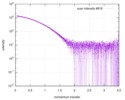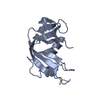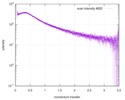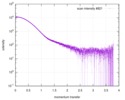+Search query
-Structure paper
| Title | Machine Learning Methods for X-Ray Scattering Data Analysis from Biomacromolecular Solutions. |
|---|---|
| Journal, issue, pages | Biophys J, Vol. 114, Issue 11, Page 2485-2492, Year 2018 |
| Publish date | Jun 5, 2018 |
 Authors Authors | Daniel Franke / Cy M Jeffries / Dmitri I Svergun /  |
| PubMed Abstract | Small-angle x-ray scattering (SAXS) of biological macromolecules in solutions is a widely employed method in structural biology. SAXS patterns include information about the overall shape and low- ...Small-angle x-ray scattering (SAXS) of biological macromolecules in solutions is a widely employed method in structural biology. SAXS patterns include information about the overall shape and low-resolution structure of dissolved particles. Here, we describe how to transform experimental SAXS patterns to feature vectors and how a simple k-nearest neighbor approach is able to retrieve information on overall particle shape and maximal diameter (D) as well as molecular mass directly from experimental scattering data. Based on this transformation, we develop a rapid multiclass shape-classification ranging from compact, extended, and flat categories to hollow and random-chain-like objects. This classification may be employed, e.g., as a decision block in automated data analysis pipelines. Further, we map protein structures from the Protein Data Bank into the classification space and, in a second step, use this mapping as a data source to obtain accurate estimates for the structural parameters (D, molecular mass) of the macromolecule under study based on the experimental scattering pattern alone, without inverse Fourier transform for D. All methods presented are implemented in a Fortran binary DATCLASS, part of the ATSAS data analysis suite, available on Linux, Mac, and Windows and free for academic use. |
 External links External links |  Biophys J / Biophys J /  PubMed:29874600 / PubMed:29874600 /  PubMed Central PubMed Central |
| Methods | SAS (X-ray synchrotron) |
| Structure data |  SASDDJ3: Candida antarctica lipase B - with guanidine-HCl unfolding series  SASDDK3: Candida antarctica lipase B - with guanidine-HCl unfolding series, in the presence of dithiothreitol  SASDDL3:  SASDDM3: Carboyxamidomethylated ribonuclease A (unfolded RNAse) - with and without urea  SASDDN3: Bovine serum albumin mixture: averaged and individual data frames (subtracted and unsubtracted test sets) |
| Source |
|
 Movie
Movie Controller
Controller Structure viewers
Structure viewers About Yorodumi Papers
About Yorodumi Papers



 Pseudozyma antarctica (fungus)
Pseudozyma antarctica (fungus)
